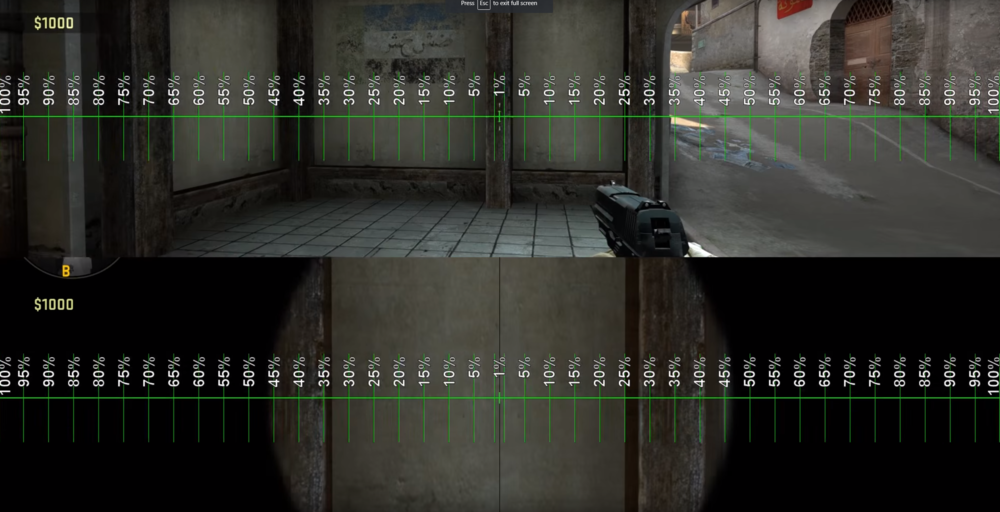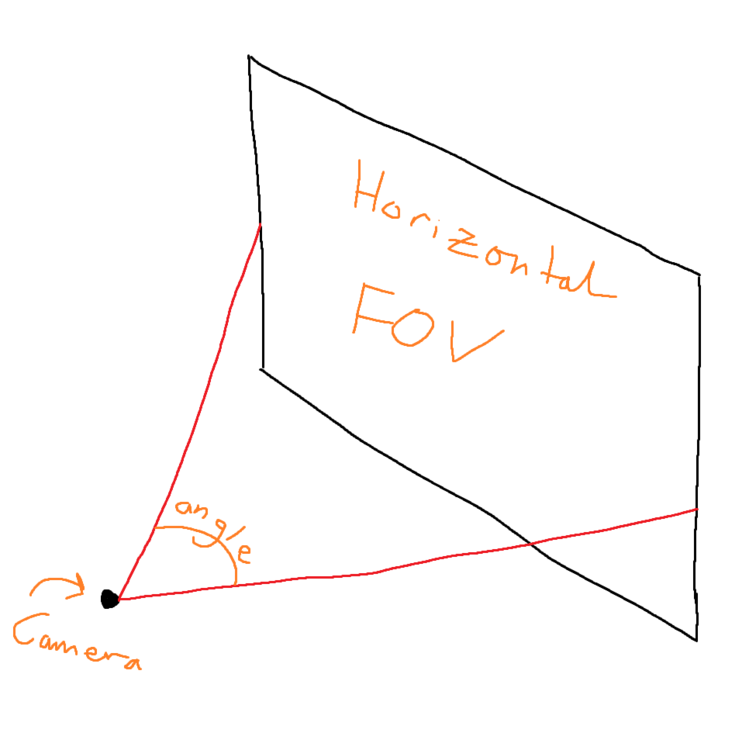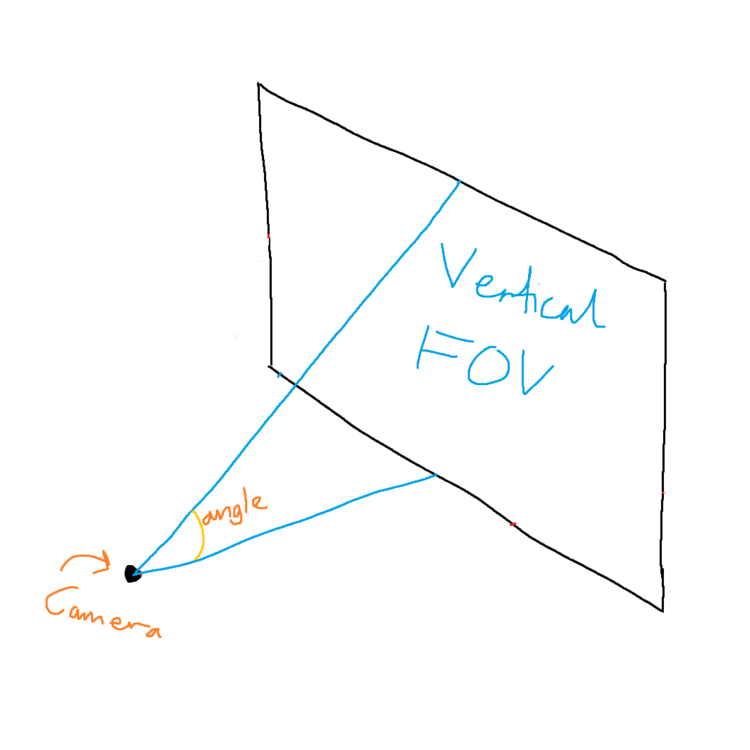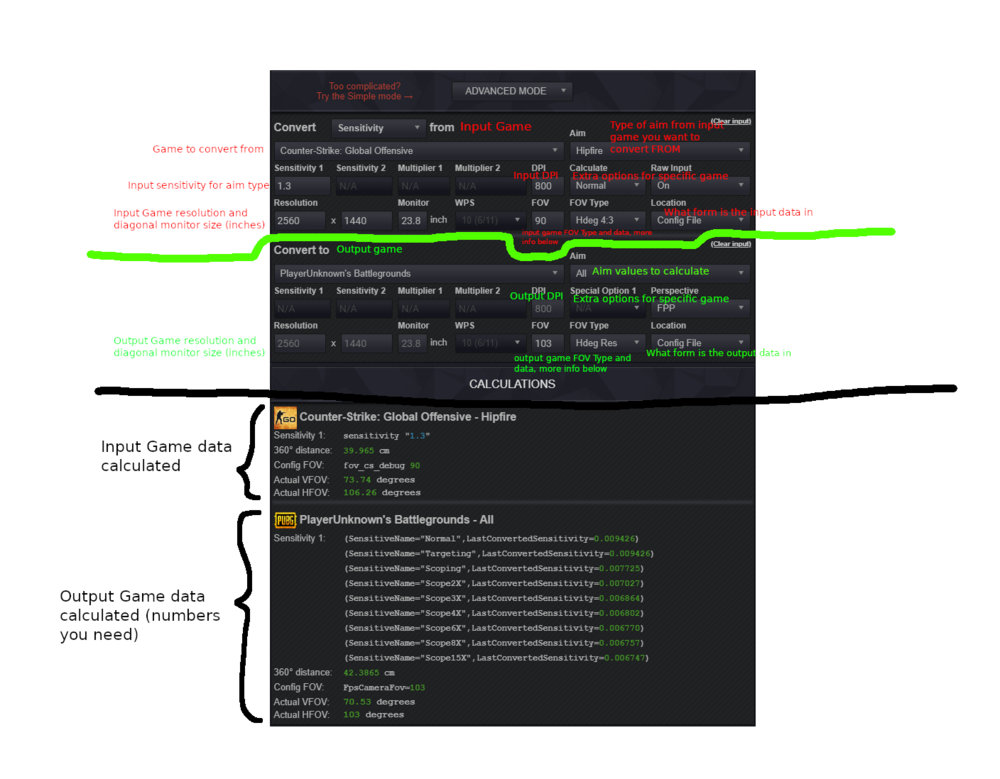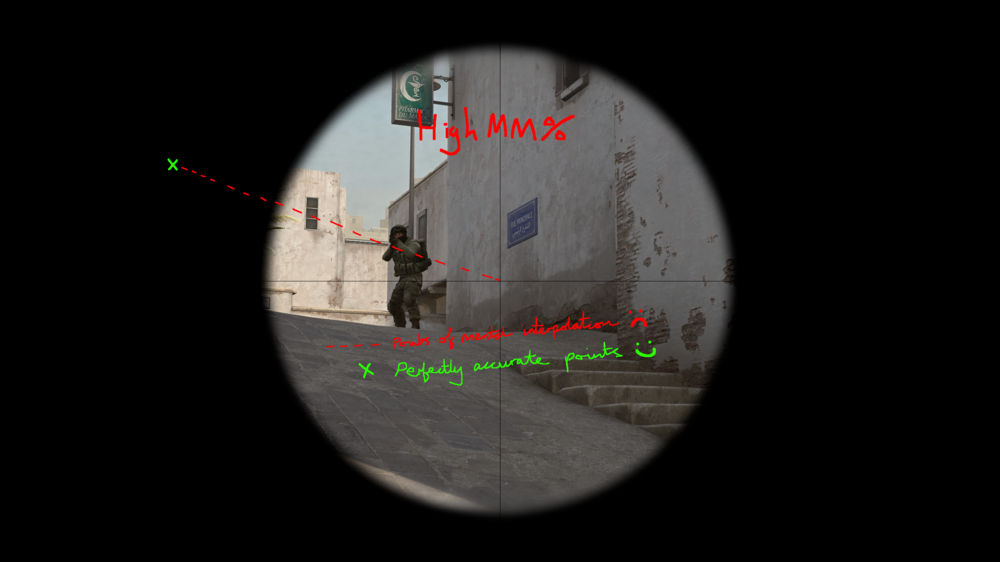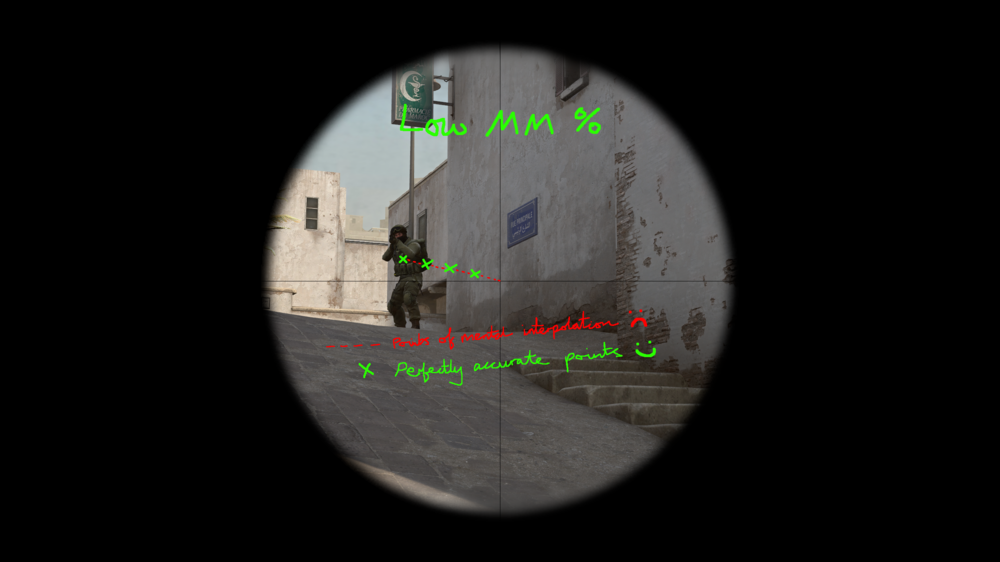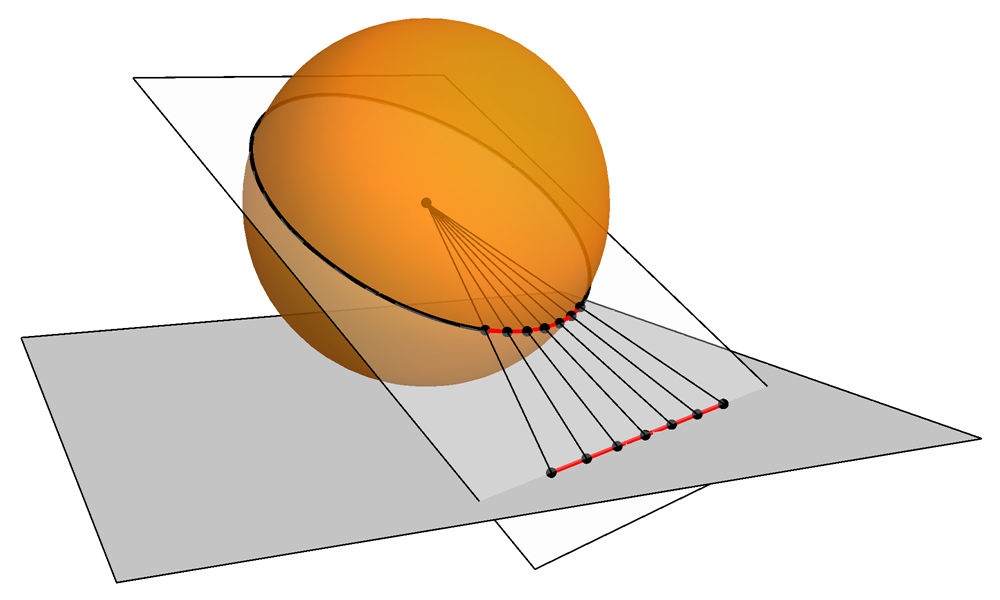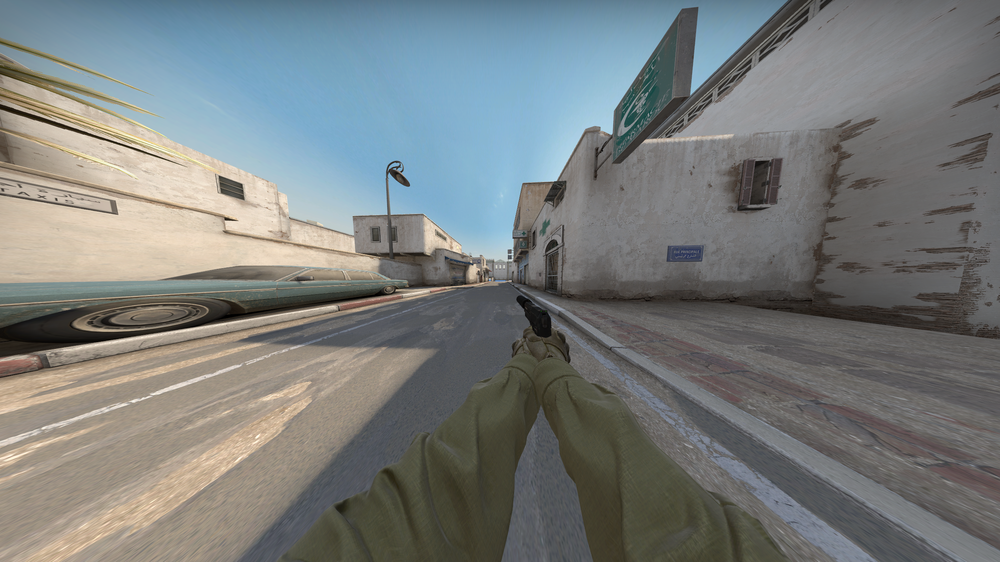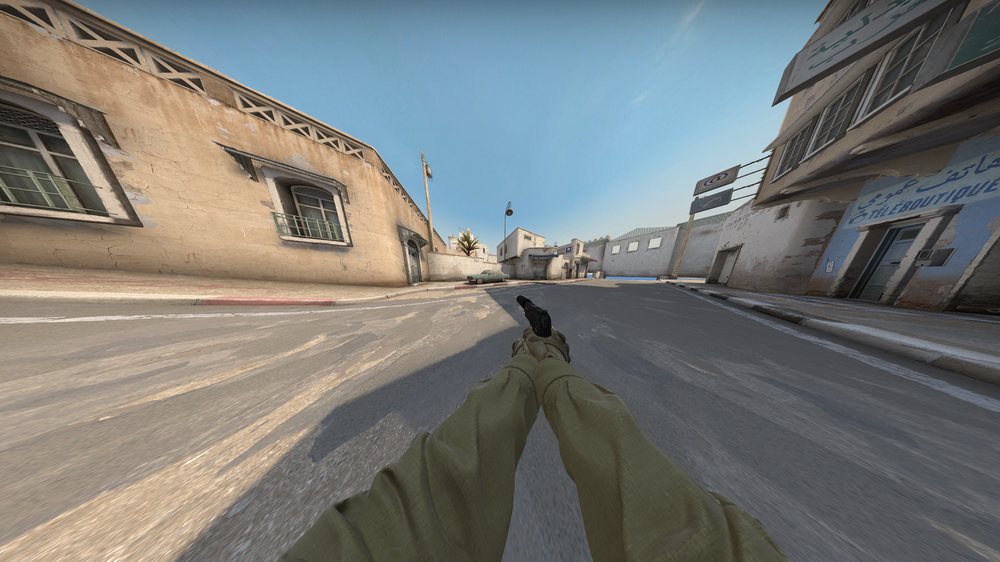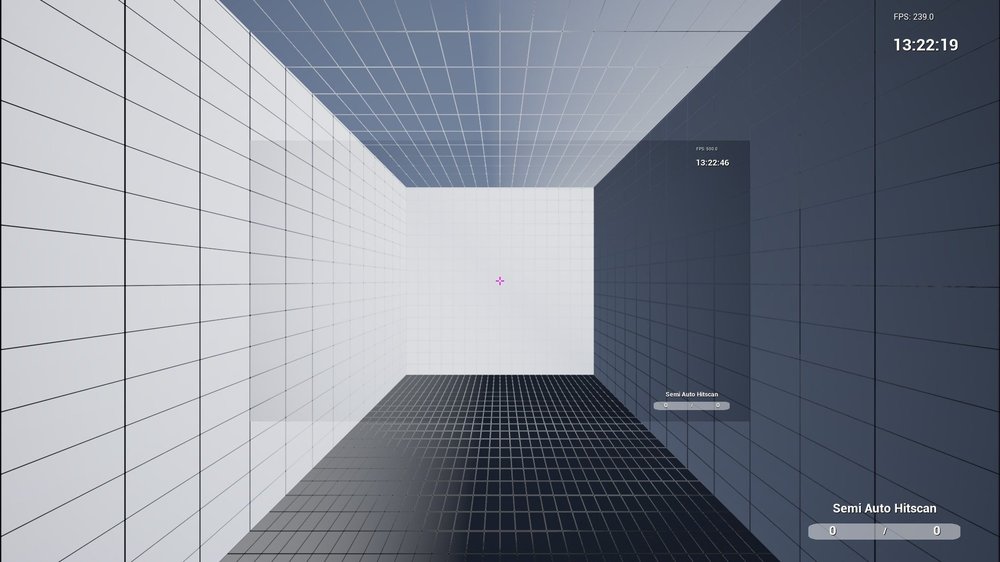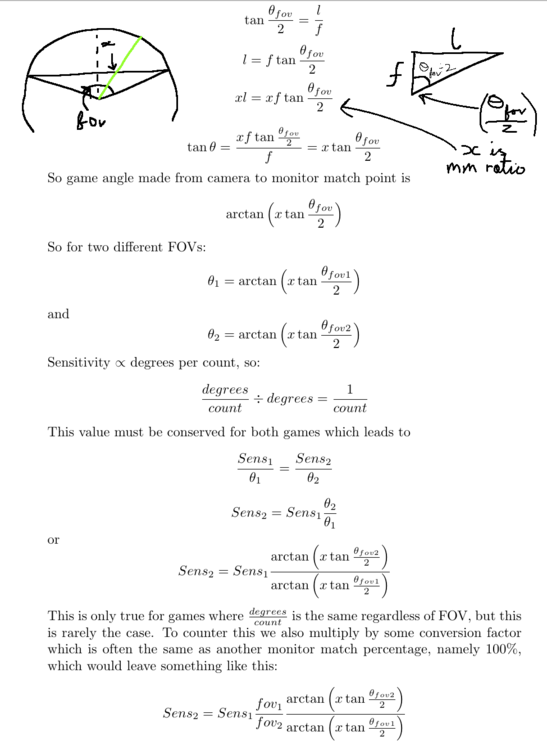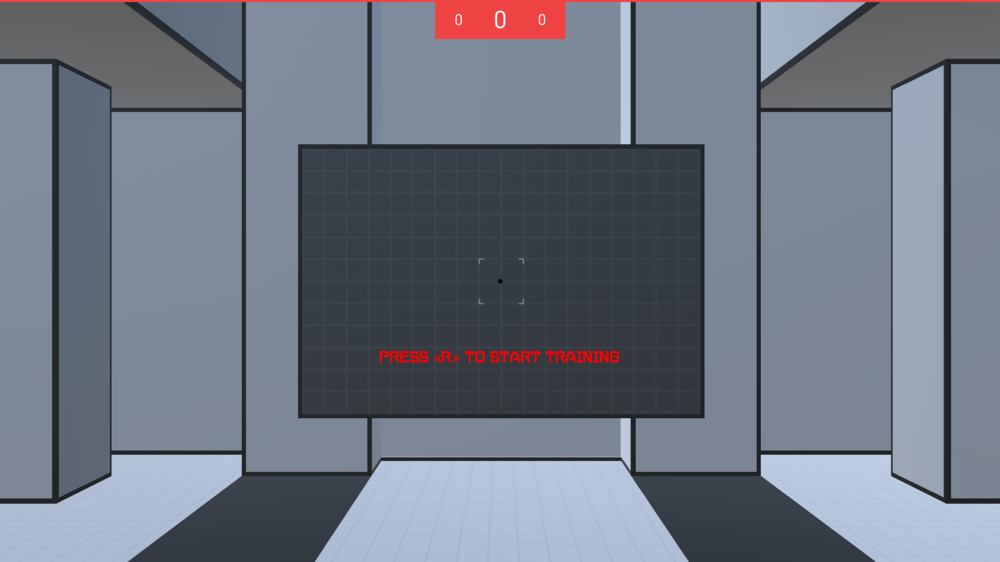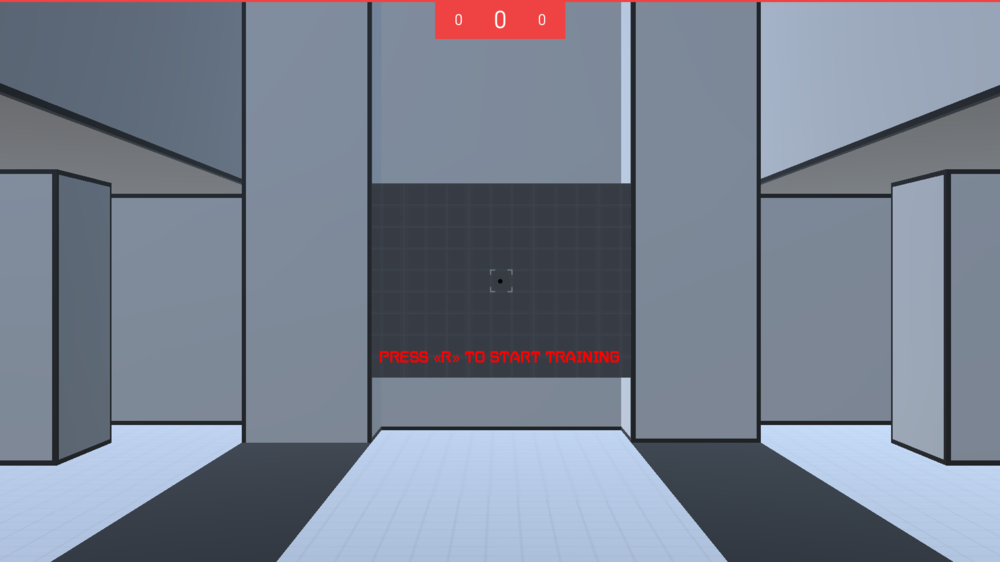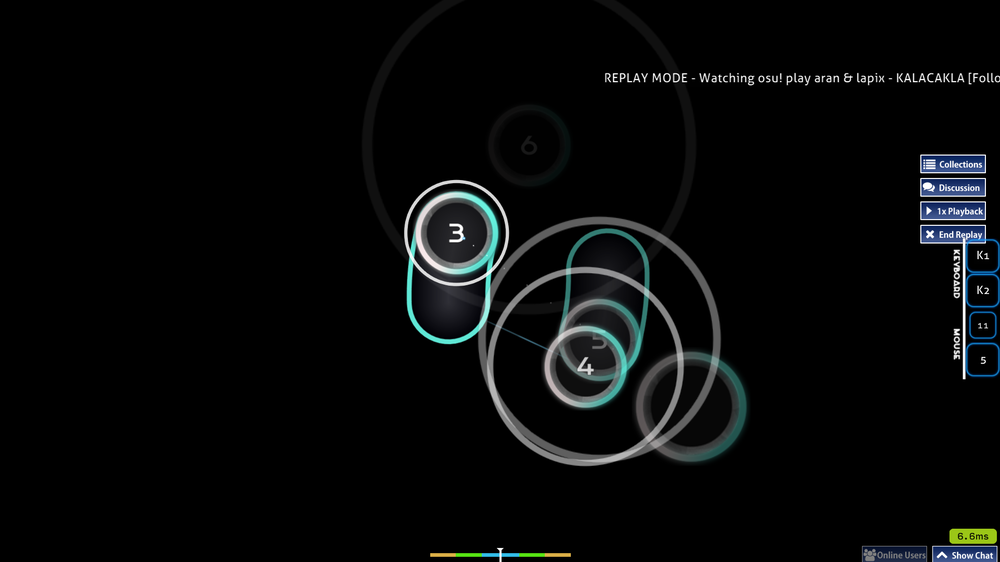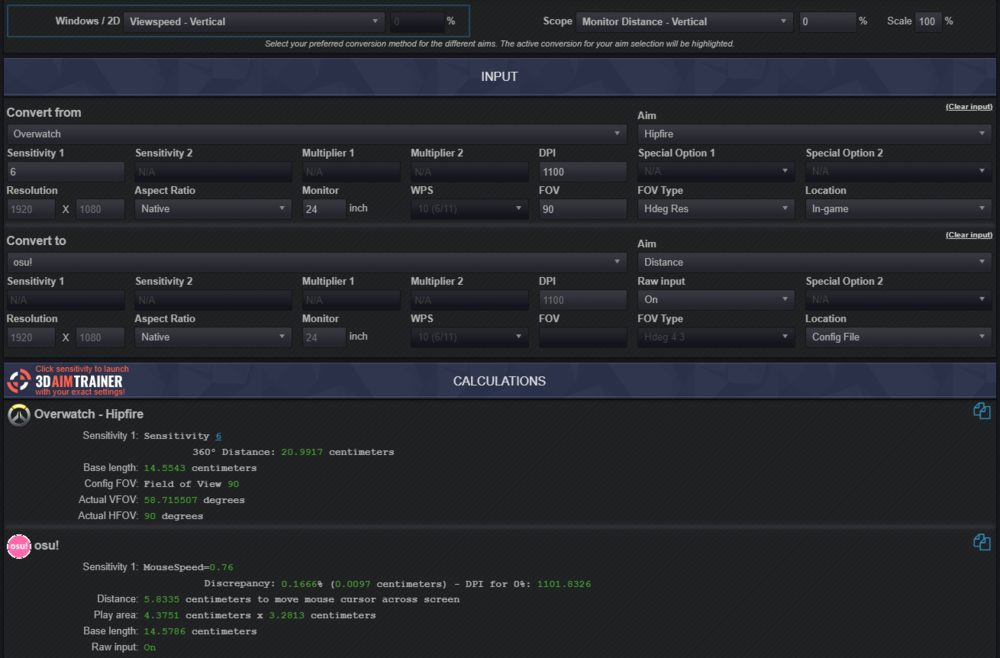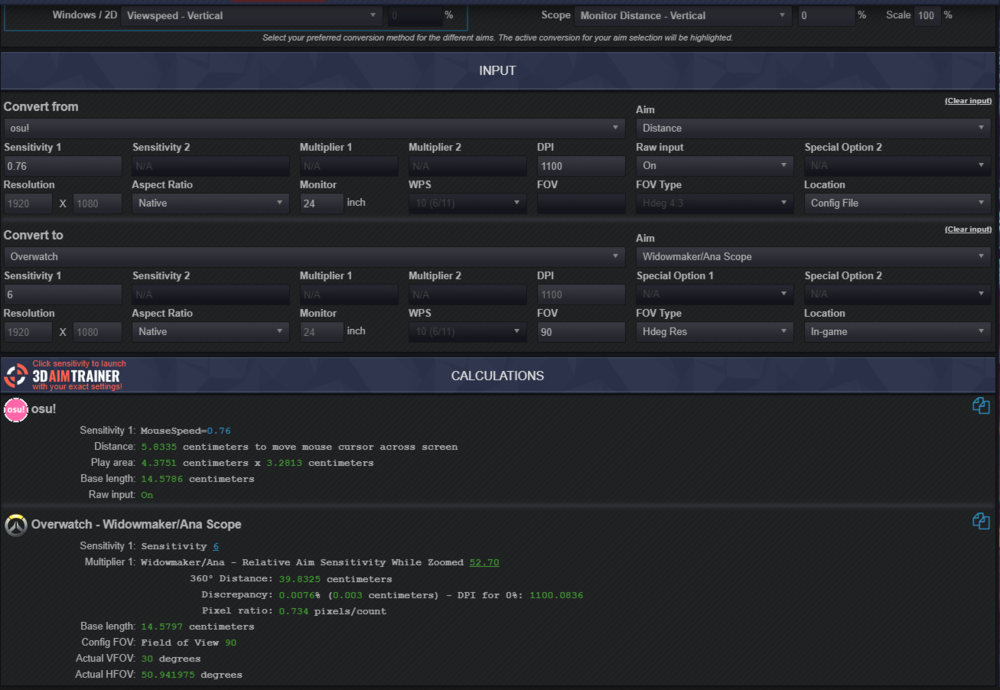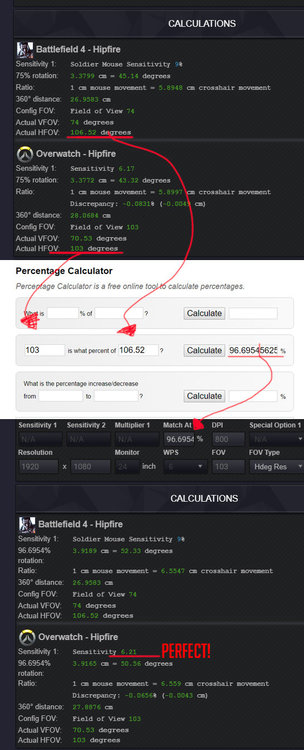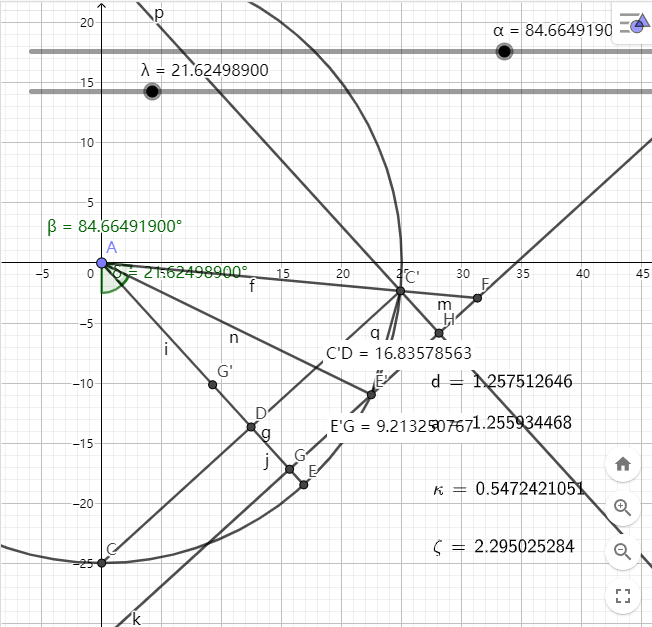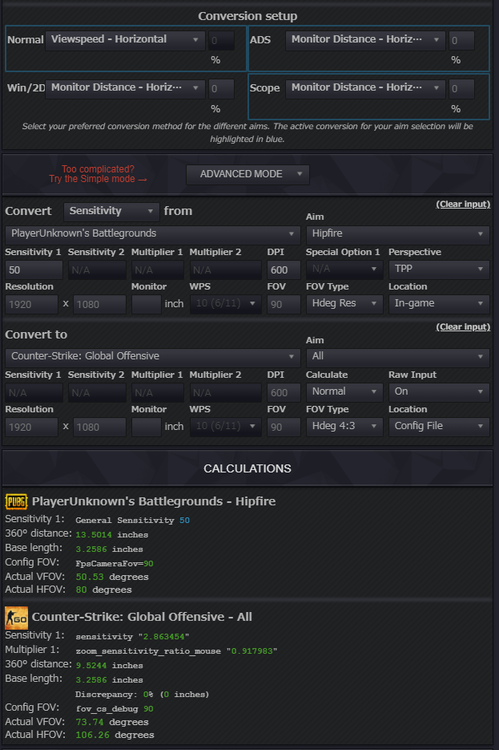Search the Community
Showing results for tags 'viewspeed'.
-
If you want something added to this main post, you can add a comment and I'll consider adding it. It doesn't just need to be about these methods, anything of value to general people in one place is the idea. My aim is to make this as non-technical as possible and so I'll try keep the language as consistent as possible, but there is some language you'll need to know and understand in some form. Key Language How to use the calculator Why there isn't one perfect conversion for 3D games: When playing a 3D game the information is displayed through a 2D monitor. We encounter the same problem map drawers had many years ago, there's many solutions that go about it in many different ways but all have their benefits and drawbacks. Gnomonic projection is what 3D shooter games use and is what we're all used to and it works by taking points on the sphere through to a camera and where it intersects a plane which is the monitor, we colour the pixel that colour as you can see if you click on the images, look at the car in the CS:GO images. This creates distortion at the edges of the image as rays that get closer to the max FOV of 180° get put really far away on the plane so angles on your screen are not preserved for different FOVs (i.e. halfway between your screen and the edge on a 90° FOV isn't 45° in game) what this means is that when you have two different FOVs there will not be two respective sensitivities that match everywhere. This has lead to many methods of converting sensitivities that all have their pros and cons as there is no perfect conversion. The lists of pros and cons below should help you decide. Conversion Methods: 360° distance: This is the method most people think of when wanting to convert sensitivity, and is the one people usually try do themselves with some paper measuring the distance and then turning 360° in game and matching sens so the distance is right. This website can do this for you much more accurately but there are some caveats. This method matches angles around you in 3D space. So for example every 360° swipe will be the same, and every 180° behind you onto a target will be the same. This is good for general spacial awareness if you know someone's behind you etc.. but it's good for not much else. Plus if you know someone's behind you the other methods as you will see will put you in the right ball park anyway (unless the FOV is very different) and then you can aim more accurately with those other methods as you will see. This method will only really work if the FOV is exactly the same across the games (but every conversion method would give you the same value anyway) or you're into general spacial awareness, I give that as a pro of the method but not the sole reason to use it. Monitor distance: This method matches your sensitivity perfectly for a specific point(s) on your monitor. You can imagine a ring around your crosshair where it matches but this isn't strictly true. Why is this better than 360 distance? Well when you aim at something, your mind doesn't calculate the angle between you and your target and then aim that much angle, instead we're more bound by how much distance there is on the screen between our crosshair and them. This means you may not be accurate turning around 180° but you'll be more accurate for the targets on your screen around where you've set your perfectly matched 'ring' up. This is good as you'll be better aiming at targets on your screen over different FOV's and also, due to using it matching distance on your monitor, we can use it to convert hipfire sensitivity to ADS sensitivity. Anyone who's tried to use 360 distance on a scope will see what I mean, and why 360° distance is bad for muscle memory aiming at targets near your crosshair. What about the different percentages?? The percentage is the ratio of the distance from your crosshair to the point on your screen you want to match on and the edge of your monitor. In simpler terms, it's the point from the centre to the edge you want to match. 50% is in the middle of your crosshair and the edge of your monitor, 100% would be matching at the edge of the monitor and 0% would be matching on the crosshair. This is shown best on the image below, taken from this video which is a very good watch if you want more understanding. What's the difference between vertical and horizontal monitor match?? The image above shows the horizontal monitor distance match, going from the centre to the left and right edges of the monitor. Vertical monitor distance match is as if you rotated the scale 90° and fit it on the monitor, so instead of going to the centre to left and right edges it went from the centre to the top and bottom of the monitor. There's both options as the vertical match is aspect ratio independent (doesn't matter how wide your monitor is compared to how high it is) and therefore easier to talk about as if you have a 4:3 monitor and matched horizontally to the left/right edges of the monitor that would be 100% monitor match, but if you were to talk about the same distance (when converting) to someone with a 16:9 monitor it would be 75% horizontal monitor match. But if you were talking about 100% vertical monitor match it would be the same for both 4:3 and 16:9 monitors. So if you talk to someone about it on the forum you will need to say which you're using, and if horizontal you'll need to give the aspect ratio of your monitor. Keep in mind there's nothing fundamentally different between them they will both give you the same values if you use the same converted mm% e.g. 100% vertical mm -> horizontal mm (16:9 monitor) 100%*(9/16) = 56.25% So 100% vertical monitor distance match will give you the same sensitivity values as 56.25% horizontal monitor distance match on a 16:9 monitor 30% horizontal mm -> vertical mm (4:3 monitor) 30%*(4/3) = 56.25% So 30% horizontal monitor distance match will give you the same sensitivity values as 40% vertical monitor distance match on a 4:3 monitor What's the best percentage monitor distance match?? This has been of much debate on this site, and I guess will continue to be as people have different opinions and so I'll try give you it as unbiased as possible. The best % to hold up mathematically is 0% and from experience myself and should probably be under it's own name you may hear it called zoom ratio but I'll keep it with this section for sake of simplicity. This is the best I've tried after I've gotten used to it. Every other % match is essentially just arbitrary change in sensitivity that may happen to be close to preference, and if you chose it it's down to personal preference, for example 100% 4:3 horizontal monitor distance match (75% 16:9 horizontal monitor distance match) is what CS:GO use for their scoped sensitivity conversions so if you've gotten used to this and you're some pro legendary AWPer, this might be the way to go for you when converting in other games. One thing to bare in mind when using anything other than 0% everything around the crosshair not on your mm% is essentially not matching at all and you're mind is interpolating the sensitivity, so muscle memory will take longer to build but with 0% you're muscle memory is at the crosshair, so things like micro adjustments when making a big flick (which is what happens in every flick, you're not perfect), and controlling recoil back onto someones head is perfectly matched across all FOV's and this is the massive advantage of low % matches. The video below will show you what I mean by only certain points match, and that everything other than those points is too fast or too slow as your mind has to guess: This video shows 1-100% monitor match with the relative feel of speed The only real advantage of larger % matches is when making large flicks out of your view onto a specific point, and the speed feels 'right' but with 0% your flicks will feel slow at first but after a while they'll be really accurate no matter where they are on screen as it's just constant really quick micro adjustments. Here's some examples showing a low mm % vs a high mm%. You can see when aiming at the target with the high mm%, the accurate point is further away from the target, so the sensitivities in the middle will be made up by your mind as it has no reference to an accurate sensitivity you converted from. Your mind would learn these made up sensitivities over time with the larger mm%, but in my mind I'd rather have muscle memory for everywhere on the screen through these small adjustments with a low mm %. With a low mm% you can see here there's been 4 'micro adjustments' which can make it's way onto the target with multiples of your perfect accuracy. You can imagine this tending down to smaller and smaller intervals as you approach 0% Math for nerds: Here's a link to a geogebra page where you can hopefully better understand the maths and what's going on, with thanks to capta: https://www.geogebra.org/m/adAFrUq3 View speed: Viewspeed tries to unify the perceived camera speed across different FOVs while using a constant mouse motion. Since the FOV determines how many degrees are squished onto your screen, higher FOVs naturally look faster as there is more information moving, and low FOVs naturally look slower, and Viewspeed attempts to equalise this. And it does 'feel' right when you use it. But feeling the same in this case doesn't translate to best aim or muscle memory building. It suffers from the same problems as high monitor distance match percentages, aiming close to your crosshair is too fast for varying FOV's Because viewspeed uses a sine wave (continually varying), when you calculate sensitivities over different FOV ranges, you get a varying equivalent monitor distance match percentages across FOV's. It lies around 60-80% for 16:9 horizontal match. It's useful If you want to keep the mouse input relatively the same when you change FOV on the fly. It scales based on the chord length. This is the method that you would want to use instead of Monitor Distance Match, if you wanted the 'window to the game world' to influence the sensitivity. Your mouse input will not scale proportionately with the zoom. Instead, you wouldn't scale it at all. The result will be completely wrong for Hipfire, but when comparing sensitivity relatively before and after a change in FOV, it becomes useful. Subconsciously, you would want to scale your mouse input according to the change in image, so you would probably scale your mouse input to some degree, how half-assed of an attempt at doing so, depends on the person. This makes Viewspeed feel too fast. Drimzi made a solution to this in another post, where you specify how much you need to scale your input by, proportionately with the change in image (zoom), or none at all (viewspeed). Which makes a kind of slider between viewspeed and 0% monitor distance match bare in mind this is completely arbitrary. Maths behind viewspeed - vertical here I made a geogebra demo, which hopefully makes the maths more clear here: https://ggbm.at/mgw8cke4 Which came from this thread which hopefully has some more insight as to where it came from. What's the difference between vertical and horizontal view speed?? In the same way vertical and horizontal monitor distance matching varies by the top/bottom edges of the monitor and left/right edges respectfully viewspeed does something similar too. @Drimziis the expert on this forum on this topic it seems, so I'll quote him: Viewspeed - Vertical : An aperture (monitor) dependent conversion, scaling the sensitivity by the change in Vertical Chord Length. Viewspeed - Horizontal: An aperture (monitor) dependent conversion, scaling the sensitivity by the change in Horizontal Arc Length, as well as the difference between Horizontal Arc and Chord Lengths. The Viewspeed methods don't just change the measurement axis. They are both completely different methods. Viewspeed - Vertical should be using 1:1 measurements rather than Vertical. Horizontal is an older idea that was similar to Monitor Distance Match - Horizontal, but scaled by the difference in Horizontal Arc and Chord lengths. tldr: So what's the best conversion? 0% monitor distance match (- vertical) unless you're really good and/or are more comfortable another method, even then it's worth trying 0% and seeing how it goes imo. This is the best method for building muscle memory fundamentally, but might not work well practically for really low sens players. Also remember, don't copy other people's set up because they're good. Unless there's a good reason not to use what you're using for technical reasons, find what works for you. (I'm mainly talking about weird resolutions and stretching) Other FAQ's High DPI or Low DPI? (+ pixel skipping) : This question get asks a lot and is unknowingly the wrong question to be asking. As explained in the key language section, DPI or as I will be changing to the right terminology here, CPI (counts per inch) is the number of counts registered and sent to your computer when you move your mouse 1 inch. Now a count is just telling your computer to move 'some' amount. and more counts coming in means just move that 'some' amount more. So changing DPI (CPI) will directly affect your sensitivity, but in neither a positive or negative manner. It will just make you move more lots of 'some' angle in game or more lots of 'some' distance on the desktop. So the question should really be how do you decrease that 'some' distance/angle so that you can be more precise. If you want to get a better understanding of this 'some' distance see this thread there's some nice gif's Well for games that's by decreasing your sensitivity and then in turn increasing your DPI to keep the overall sensitivity (sometimes referred to as eDPI) the same. So if you half your sensitivity, you double your DPI. So yes, if you want more precision you should decrease your sensitivity and increase your DPI. This video shows it very well, along with WPS skipping. Keep in mind he talks about pixel skipping, not angle skipping (which is what's happening) Bare in mind: This becomes solely placebo after a certain point Increasing your DPI too much can have a negative affect on your accuracy as your mouse starts interpolating to make up counts Some game's minimum sensitivity values mean that if you went too high with your DPI, you couldn't get the right sensitivity to match other games. This starts around 1600 DPI. This will change your desktop sensitivity (read next Q for recommendation) Windows pointer speed (WPS) 6/11 ? : Windows pointer speed relates the that 'some' distance moved for each count mentioned in the prior question. The reason 6/11 is accepted as the right setting for gaming is that here the multiplier for that 'some' distance is 1, and 1 x anything is itself so this means the data coming from your mouse to motion in non-raw input games is as if windows wasn't messing with the data (even if it is still adding a slight delay/packet loss which is why raw input is the better option). But 6/11 isn't the ONLY correct option as lots of places seem to state: here is the list of acceptable ones (this post has further correct options but they involve registry edits). Control panel notch: 6/11 --> 1x count multiplier 4/11 --> 0.5x count multiplier 3/11 --> 0.25x count multiplier 2/11 --> (1/16)x count multiplier 1/11 --> (1/32)x count multiplier Why are these valid options? Well you can multiply all the multipliers by a integer to get back to 1x because they're all fractions in the form 1/n What this means practically is that even with these options you'll never miss an equivalent spot where 6/11 would be correct, so no skipping. This means if you use a higher DPI for games to be more precise (skip less angles) but it means your desktop sensitivity feels too high for you, you can chose one of these options to get it back to a desktop sensitivity you'd prefer. Same desktop sensitivity too (adjustable DPI mouse) ? : My recommendation here is for if you use 0% monitor distance match for everything, is to convert from your 'best aim' game to desktop as so (using windows desktop), then using this sensitivity to get sensitivities for all games. I'd also recommend using a lower WPS as talked about above if you use a low sensitivity as low DPI values can be output. Why do this? Well it means that all your sensitivities in all games are the same, and if you wanted to increase your sensitivity in all games, all you'd have to do is increase your DPI, and all the overall sensitivities including desktop will increase perfectly without needing to calculate new sensitivities for each game. Here's an example converting to windows to get the DPI, then back all your other games, keep in mind the right display scale from your windows monitor settings and WPS benefits from earlier: keep in mind this only works if you use 0% monitor distance match for everything. If you want to use another method to convert to desktop DPI, you won't be able to convert back to the other games using desktop as the source, you'll need to use the game you converted from with the new DPI value and appropriate sensitivity. 0% will match the speed at the centre of the monitor which is perfect but as the cursor moves to the corners of the monitor it will feel slower as it's physically further away from you. You can reduce this feeling by moving your monitor back or in a perfect scenario have a curved monitor. As an aside this also applies to games, your sitting distance will less affect your perceived sensitivity the further away the monitor is, but there's more of that in the threads below along with the negatives, can't see small details. You can convert to desktop using other methods like viewspeed, you just won't be able to convert from it to other games. Best cm/360° ? : There's no one value I can give you for this as at the end of the day it's down to personal preference, but I'll give you a few considerations for practicality. My assumptions here are based on a pretty average FOV for shooter games, around 103°. First thing to consider is the size of your mouse pad: My recommendation here is you can do at least 180° on your mouse pad and at most 360°. Why at least 180°, well if there's someone behind you and you start spinning and hit the end of your mouse pad before you can rotate enough to hit them you're pretty much dead if they're any good as you'll have to pick your mouse up move it back and swipe again, plus it gets pretty laborious if you have a large mouse mat. Why max 360°, well in most shooter games your main focus is aim, and if you can do more than a 360° on your mouse pad, you're giving up accuracy everywhere in your view for being able to rotate fully, then some more when you could've just moved that 'some more' distance in the first place. What kind of games you play: Some games may require a really high sensitivity for fast moving tracking on a large object, tbh the only thing that comes to mind is Minecraft but I'm sure there's other games out there... A swipe greater than 360° may be favourable here but only if you play only these games or you have a different sensitivity for these games. If you use this in a FPP game, you're using at the detriment of accuracy unless you have a really large mouse pad. Large mouse pad: I've talked a lot about degrees turned on the mouse pad above, but for people with really large mouse pads they have the freedom to set the sensitivity however they want as following those guidelines may make the sensitivity too low for faster paced games or too low that if you convert with 0% it's hard to play with. The optimal range for this kind of thing seems to be about 30-40cm/360° At the end of the day go with what you are comfortable with but they're just some hopefully useful guidelines. This thread is useful and goes into some more discussion also about mouse speed Matching FOV by changing resolution ? : In some games, you can't match the hipfire FOV to another game because the FOV slider doesn't go high enough. There is a way around it which and I wouldn't recommend the hassle, but here it is: By changing your resolution, you can shrink the image down so that your focal length (distance from camera to whole screen) changes to match the other game. You can do this by scaling down your image so you have black bars on each edge and the black bars contain the FOV that you're missing. For example setting overwatch's FOV (103) to the same as CS:GOs(106.26) you can hide the 3.26 degrees you're missing behind black bars on your monitor. You can see the focal length is now the same as the images match up. But the bit around the outside would be the hidden FOV. It's quite hard to imagine this, so here's a geogebra calculator/demo to show what's going on, enter your resolution on the top left and drag around the FOVA and FOVB nodes, notice the blue triangle on the left has a smaller size on the screen, the same focal length and the same FOV as FOVB: https://www.geogebra.org/classic/wg83gxjc You can see that this only works for making a smaller FOV bigger, the other way round your rendered image would have to be bigger than your screen so you'd be cropping loads of pixels. The output resolution is in the top left below the input. Also note for this to work you need to in the Nvidia control panel set the scaling mode to none and make a custom resolution: Thread references and useful topics:
-
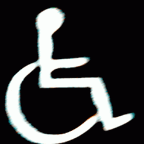
Conversion of sensitivity from 2D to 3D windows
Vaccaria posted a topic in General Gaming Discussion
Hello everyone. I want to share my findings and observations after a long study and testing. I will not try to transfer everything from my head to the text - it is corny it is difficult. But I can try to answer the questions you may have. My learning path began with a professional overwatch player "EFFECT". Who trained a lot and already had a set of settings in osu (2D) and overwatch (3D). It is not known where he got the settings, but it is known that he changed them and looked for similarities, most likely empirically. Even I managed to easily transfer from osu to hipfire overwatch. It remained to figure out how to transfer to ADS and Scope. He just needed to train and slowly achieve accuracy. Recently I read the threads on the forum and was surprised that I am the same person as others, who was looking for an answer, what to choose when converting and what numbers to write. People who understand how formulas work, which is the most appropriate, say 0% or 100% (start with these) You cannot aim without eyes. You shoot with your eyes, the eyes transmit information to the brain, the brain decides to move the mouse - to press the button. You need to train the motor skills of the hands, eyes, body, etc. But when you play games, at first you adapt, the discomfort is removed. After that, you already find yourself on an empty field, because the adaptation stage will pass, and you need to create something that will develop you. There are several rules that I will highlight at once. In mathematics, there are no wrong numbers. The calculator gives the correct values anyway. These numbers in the answers are simply at odds with your habits. You always need to create settings for yourself: sensitivity, FoV, hand position, type of mouse grip, etc. There is no magic pill that will help you from 2D to become effective in 3D. Hipfire is no different from ADS, Scope, etc. These are the same numbers, the same movements in the game. They also need to be trained separately as Hipfire. To train them, you need to get to know them. The topic is extensive and I might miss something. But the first rules that come to mind are enough. When I use the standard conversion scheme of 0% or 100%. My cursor will feel slow in 2D and fast in game. But in the game there is a displacement along the sphere, and in 2d along the plane. How to train such different movements? I went further, and started increasing the %MDV to FoV, thereby starting to decrease the monitor in the monitor (if I can put it that way) https://www.mouse-sensitivity.com/?share=6bbebf26c14ce140e9782268b252c306 Having achieved some similarities in the movements and range of work of the eyes, brain, hand. I understood what had happened. Having a different focal length from the monitor to the eyes. The eyes will work in different ways. I play in osu and track each note in different positions on the monitor with my eyes, my eyes learn to move quickly and focus on a specific point on the monitor. Next stage What grip to use and what part of the hand to use when moving. I will not disassemble other types of grips, as having a 20-21 cm long and 10-11 cm wide palm, I am not able to use the correct palm grip and claw grip. I began to study. What are the types of mouse grip, there is a lot of information, but in short, AS IT IS COMFORTABLE FOR YOU AND KEEP. This approach did not suit me. And I began to disassemble in detail the grip of the fingertip / fingers. After studying and testing, I decided to use a similar grip like that of a professional player. Now, having knowledge, you need to apply them. I have a training ground and this is Osu! It can train hand / finger motor skills, eyes, finger grip. Trying to put it all together! Eyes move and focus on different positions on the monitor. Finger movements are synchronized with your eyes, then where you want to move the cursor. Fingers range of motion appears в 2D, now you need to transfer this range to 3d. Here AimHero enters the ring with its convenient field size. The principle is the same, now the eyes are being trained in the 3D sphere, more precisely, it is the same 2D monitor, but the sensations from the movements are now 3D. The eyes also move to the same positions on the monitor as in osu. But the effective distance is changed by the field. Now about the distance of flick and / or fingers tracking. What is the point of these trainings if the aiming style is not created? I created mine and it is an example. Grip - fingers. The fulcrum on the table is the forearm. The wrist is not in contact with the mousepad. The elbow hangs. Flick (diagonal) - fingers. Flick (horizontal) - wrist. Flick (Vertical) - fingers. Horizontal tracking - wrist. Vertical tracking - shoulder. The rest of the movements in 360 (fine-tuning for the working range for the wrist, fingers) on the fulcrum is the forearm. Since there is no more friction between the wrist and the mousepad, movement feels uncertain - it's all a process of adaptation. Now how does the conversion take place not to hipfire, but to ADS, Scope, or, more simply, to a smaller FoV. There are several options, but I'll show you 2. Make a 1-to-1 sense of the pixel speed Viewspeed-Vertical In Osu, the value remains x1.07, in the calculator when calculating with VSV x0.76. These two values are equal. When calculating for different FoV using VSV, the visual speed will always be different, but the muscle memory will hit the target. It all works and has been tested my aim style. The settings may be convenient, but not effective. Mouse grip can be handy, but not efficient. etc. Everything needs to be created for yourself. And not blindly copy from other pro players. Science has not entered this market, so you need to study and create for yourself. I put everything in a heap and did not paint everything down to the pixel. Therefore, I will try to answer for those who will correctly formulate the question. -
Hi guys. First of all, I don't mean to criticize any other method of doing it. The calculator tool is amazing and I greatly appreciate it's functions. It's just that none of the presets feel that good to me when I switch between games. I propose a better way of calculating sensitivity between games by comparing FOVs in a sense. TL;DR (I've attached a picture of what to do at the bottom!) For a while now I've tried every possible combination of monitor distance and viewspeed v1 and v2 and just straight up 360sens etc and it has NEVER felt accurate between games. Obviously this is because different games use different FOVs. The solution to this problem was supposed to be Viewspeed or Match monitor at 0% however none of these options feel right either. So what gives? Well, after playing BF4 for a couple of hours I started thinking about how they use the USA coefficient to dynamically change the sensitivity based on the zoom of your weapon and how it almost always feels accurate, regardless of zoom. We're used to thinking its viewspeed, but it doesn't feel right when using it for other games. So what I did was this. TL;DR end I looked at the ACTUAL Fov of hipfire (for me that was 106.52in BF4) and I looked at the actual FOV in Overwatch (for me that was 103). (use any combination of games with different FOVs that you'd like to try this with.) Overwatch is 96.6954% of BF4's FOV for me. So In your magical calculator I matched the sensitivity at 96.6954% monitor distance. For the first time ever, my sensitivity in Overwatch actually feels accurate. My aim is on point comparable to BF4. I'm Division 1 in BF4 and 3.9kSR in OW if that matters to anyone. Using the exact same method, I also calculated that Widow Zoom 42 was optimal and I can tell you after a few hours that it feels better than any other setting. Such as 38% or 44% that we hear so much about. I'm garbage at math so I had to use this website for this stuff.: https://percentagecalculator.net/ 51FOV is 49.5145% of 103FOV. Matching my hipfire sens to my ADS sens by 49.5145% results in an ADS sens of 42. This felt fantastic when paired with my new hipfire sens I got from BF4. I also tried this with CS:GO and same thing there, now my sens feels great. So for you to use this technique you just need to pick the game you are best at, where you feel like you perform at your best and compare the FOV and match monitor distances between that game and whatever other game you want to play. You can also use this for Zoom levels in the same game. P.S: Setting the Battlefield Coefficient to 177% for 16:9 aspect ratio has the same effect. (set it to 1.7778 in the config file if you want to be extra picky). Sorry if it was hard to follow, English is my 2nd language.
-
-
I've tried 0% but I feel that it is tad bit slow so I tried out 56.25% but was told that people used that measurement when a vertical option didn't exist, instead use vertical monitor match 100%? What does vertical option mean exactly I'm a bit new so It's not to obvious to me. Distance vertical 100% = 56.25%. So do I just use 100% monitor distance vertical for every game? Also what do you think about view speed as I'm considering it as an option. Final thing (56.25%): One of the games that I play has a different fov multiplier for different guns (fov=64.375 for ak and 73.57142857142857 for revolver) as well as different sens. So what I did was convert my csgo sens to kovaaks at 1:1 fov measurement for kovaaks (that's how the fov of the game is measured apparently) and then used the program sensitivity matcher to match those different sens. Then I went ingame and sens matched again to get the values: Tesing 76% 2.2740 eg 1.72824 360/cm monitor matching 56.25% for ads { hipfire fov: 103 Rev- Rev sens based of kovaaks(fov=73.57142857142857):1.7242938 sens matcher: 0.0379345 (rough) sens ingame: 0.386218 Ak- Ak sens based on of kovaaks(fov=64.375): 1.5087572 sens matcher: 0.0331927 (rough) sens ingame: 0.386218 } as you can see the values are the same for both weapons, wouldn't these make it inaccurate? Also monitor distance vertical 100% would be the exact same so yeah I don't really understand could someone clarify this for me? Thanks
- 14 replies
-
- sens
- sensitivity
-
(and 4 more)
Tagged with:
-
I've been doing a lot of testing for hipfire I feel that the sens differs in different games far to much. For instance if I used csgo (2.272500 hipfire for all games) to fornite with monitor matching 0% my sens would be 0.057 where as if I measured it with 360/cm it would come to 0.09, in another game it's the opposite (to high). So would it be better to use 360/cm for hipfire? Also for ads sens what is recommended and what are the differences between viewspeed monitor matching (0%, 56.25% and 100%) and why should I or should I not use them. I'm a bit new to all of this, forgive the noobness
-
i would like some help converting destiny 2 to R6. i watched the video of the conversion setup ex: 360 distance or viewspeed. i still dont understand it. im new to pc gaming. i have a 9 sens on 2560x1440p 27in monitor 400dpi and 90 fov. my fov in rainbow is also 90. if someone could explain do i need to change 360 distance or viewspeed etc i would be very grateful
-
So I understand how to convert my CS sens (2.915) to other games hipfire, such as Siege. If I'm correct I just change all the conversions at the top to viewspeed and then do CS to Siege, enter my sens and my fov and that's it (right? ). But I get a little confused when I want the same viewspeed for CS hipfire and AWPing. What I have done is put the top and bottom games to CS:GO, but the top one is hipfire and the bottom one is set to the Zoom 1 option. It gives me a zoom ratio of 0.978. Obviously this is barely any difference to the default zoom ratio in CS which is 1, and I thought it would need to increase for it to match my viewspeed, maybe I'm wrong. I just wanna check if this is right or wrong. Thanks.
-
Hi, I'm new here, and I recently began calculating "Viewspeed 2" instead of "360 degree distance" for the obvious benefits. Viewspeed 2 is phenomenal, and it feels right, so I won't be switching back. But I noticed that, unlike the 360 degree distance calculator, the calculator for Viewspeed 2 does not list any "discrepancy" percentage. Why is this? The discrepancy percentage is very useful for games like Destiny 2 which have big leaps of sensitivity steps. Using the percentage, if it were listed, I would theoretically be able to easily tweak the FOV to hone in on a more accurate viewspeed. I hope it's possible to add the discrepancy percentage to the other calculator outputs. Let me know. And thank you!
- 4 replies
-
- calculator
- fov
-
(and 2 more)
Tagged with:
-
What should I use to get my sensitivity from csgo to pubg, view speed v1, view speed v2, or 360 distance? These seem confusing to me and i just want pubg to be as similar as csgo.
-
Dear @Drimzi and @DPI Wizard, I get really confused by reading topic about the new Viespeed calculator. I think I got the point how the get the necessary DPI for my Windows sensitivity depending on my ingame sensitivity. But what I have to use the other way round? I mean I use Windows 3/10, 1600 DPI on 1920x1080 resultion. But wich calculator I have to choose now to get the same Game sensitivity? (also 1600 DPI and 1920x1080) Is it Monitor, 360 or Viespeed V1 / V2 ? I hope you know what I mean and can help me! Greetings, maxer1293
- 4 replies
-
- sensitivity
- viewspeed
-
(and 3 more)
Tagged with:
-
I'm new around here. In order to preserve the precise feeling of aiming from one game to another, should I use 360 distance or Viewspeed?. I've played a lot of CS:GO and want to make so that the distance I move the mouse to aim at an enemy's head is exactly the same in every other game, even with different zooms in games like PUBG which each sight comes with it's own sensitivity difference.
-
So I've been trying to get my cs go sens over to pubg the entire day. However the sens the calculator recommends when using viewspeed feels sooo slow compared to my cs go sens. Am I doing somenthing wrong, if not can someone please explain why this is happening. The same thing happends in BF1 https://gyazo.com/aa618785b42c47e0d74a3edbd7d44f18
-
I just tried out the 3D Aim Trainer which is linked in the calculator and I'm not able to twitch-shot anything. I'm using Aimbooster for a while now and my sensitivity in BF1 and other games is calculated by my Windows mouse viewspeed. It also feels like the "training" in Aimbooster helped me in games. But the sensitivity in the 3D Aim Trainer feels so weird and wrong. Is it just a feeling because of the 3D depth or may something be wrong here?
-
- viewspeed
- aimbooster
-
(and 2 more)
Tagged with:
-

viewspeed math What is the logic behind Viewspeed?
potato psoas posted a topic in Technical Discussion
Hey, I'm not sure if this has been discussed before (all I could find was some math by Drimzi here: but how exactly do you calculate Viewspeed conversions? I can't really wrap my head around just math, I want to know the process behind it. And last I tried wrapping my head around it my conversion calculations ended up being the same as 100% match at distance. I tried googling gear ratios and I found this on wikipedia but I'm not sure where to go from here - https://en.wikipedia.org/wiki/Gear_train. I assume this is the right article. -
I tried converting my Overwatch Sens to PUBattlegrounds using all three methods, but they all feel a little off. Can anyone explain Viewspeed so I can actually understand what it's trying to do?


